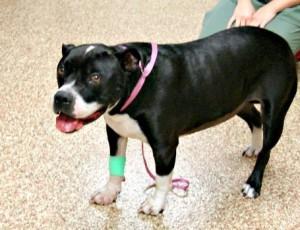
Dr. Chachkes collaborated with Dr. Coudrai to perform a foreign body surgery on a dog named Casey a few months ago. Casey is an adorable three year old Pit Bull mix.
A foreign body occurs when a dog or cat consumes items that do not pass through the gastrointestinal tract. It can happen with items such as rocks, toys, non-edible plant or synthetic materials, leashes, bones, garbage, or in this case, socks! Often in cases such as these, surgery is needed to remove the foreign body.

This is the type of sock Casey ingested.
The problems pet owners and veterinarians see when a pet ingests a foreign body depend on factors like:
- duration that the foreign body has been present
- location of the foreign body
- degree of obstruction that is caused
- problems associated with the material of the foreign body
Some foreign bodies may have toxic chemicals, like lead or aluminum, which may have health complications. Even if the material the pet has eaten is completely non-toxic, it can cause damage to the intestinal tract itself due to getting stuck or squeezed during the digestive movement process called peristalsis. When this happens, there is also a heightened risk of bacterial infection, which can be deadly.
Clinical signs can vary significantly with the degree of obstruction, location, duration, and type of foreign body. Commonly noted signs include:
- vomiting
- loss of appetite
- abdominal pain
- dehydration
- diarrhea (with or without presence of blood)
After a foreign body surgery, pets like Casey are monitored to ensure that they return to eating and that their clinical signs resolve.
For more information, see https://www.acvs.org/small-animal/gastrointestinal-foreign-bodies

